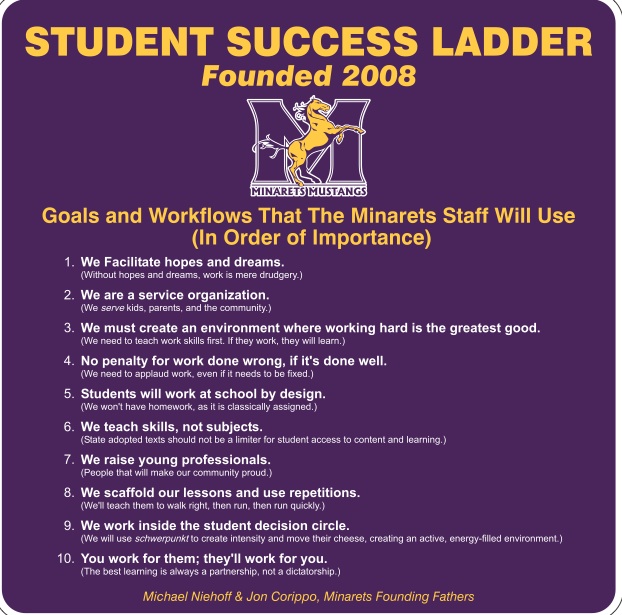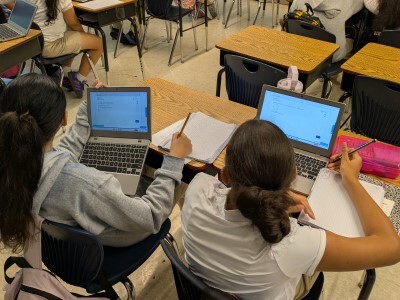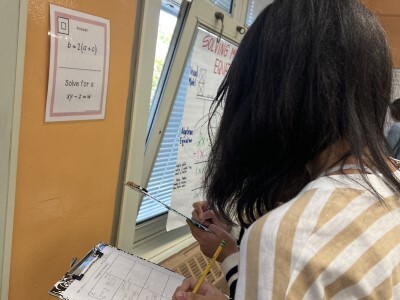How Can Today’s Classrooms and Schools Become Inclusive Learning Environments?
Topics
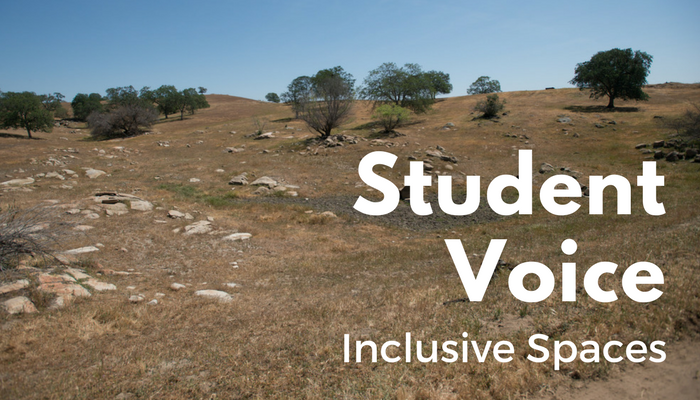
We’ve all had the experience of truly purposeful, authentic learning and know how valuable it is. Educators are taking the best of what we know about learning, student support, effective instruction, and interpersonal skill-building to completely reimagine schools so that students experience that kind of purposeful learning all day, every day.
Student Voice at Minarets High School
A 'Student Bill of Rights' and 'Student Success Ladder' set the stage for an inclusive learning environment that values student voice at Minarets High School in California.
This post originally appeared on Changing is Learning on January 15, 2016.
As the founding principal of Minarets High School, a 1:1, project-based high school that opened up in 2008, our primary goal was to create a classroom and schoolwide culture that was student-oriented in the digital age. Our idea of inclusive was that students would have a voice in all aspects of their learning. We wanted students to enjoy learning and own the experience. That’s what inclusive meant to us. Here are some of the highlights of our student culture and learning environment at Minarets High School and how we defined #InclusiveSpaces.
The Pedagogy, Philosophy, or Attitude
It starts with the talk that you have to walk: See the Minarets High School Student Bill of Rights and Student Success Ladder. We spent every moment we could reminding ourselves of the mission and unique challenge of this school. Every summer, we had a Staff Culture Camp where we re-engaged with these foundational statements and planned how to further these challenges. We continued to survey students, staff, parents, and community members in order to advance the effectiveness of these commitments. Having a school where students can express their opinion freely and openly is not always easy for the adults. But it makes both the students and the staff better every day.
Student Roles and Responsibilities
We tried very consciously to place students in adult and professional roles as often as possible. Here are a few of them:
- Student Project Coordinators (SPCs) - In addition to the traditional Teacher Assistants, we wanted students to take a greater role in the most important aspects of the classroom (teaching and learning). We created SPCs so that students, especially experienced and advanced ones, could actually co-teach and facilitate in the classroom by leading small groups, supporting students one-on-one with projects, design activities, do demonstrations, and more.
- Students and Staff Hiring - All of our interview panels, regardless of position, always had a student or students involved. Regardless of whether we were interviewing for teachers, administrators, classified staff, coaches, etc., students were on the panel, asked questions, and contributed to discussions and decisions.
- Student Feedback on Learning - One of the most engaging, interesting, and fundamental things we implemented from day one was the quarterly student survey. Four times a year, every teacher would survey their students on their learning experiences and then get feedback in order to adjust and evolve accordingly.
- Student Voice/Ownership - In addition to interviews and hiring, students helped us create new electives, create and establish traditions, name school entities, lead campus wide tours, co-present with our teachers, go to professional development with staff, host showcases, and much more.
Teacher Access
In addition to having Google accounts from 2008 on that students and staff used to connect, our entire staff published their cell phone numbers for students from day one. Teachers, principal, secretary, counselor, etc. I think students even had our custodian’s cell. The idea was that they could contact us—after hours or when they needed to. If they had questions, concerns or other, they could call, text, etc. They didn’t need to very often, but it was nice to have it available to them when they did.
Many people feel that students will abuse or misuse this. Our students didn’t. Why? One, I always say that we’re not that important. How many students are going to go home and dream about ways to negatively use our cell #’s? Two, they rarely need it. But again, we wanted to be there when they did. Over the years, we also opened up social media on campus and our staff connected with students on Facebook, Twitter, Instagram, and more. Again, some feel uncomfortable with this. However, as my colleague and Minarets co-founder Jon Corippo always said, “We go on overnight field trips with students and we’re worried about connecting with them on social media…come on.”
Inclusive Places: The Media Lounge
We were small and new and were going to only have one place on campus that had to serve as a library and whole bunch more. We went for a Media Lounge that was Starbucks meets Barnes & Noble meets college lounge. In addition to the library, it housed our Media & Video production lab. We turned office space into studio space. We turned the textbook room into our green room and a production space. We hosted live music, guest speakers, showcases, banquets, lectures, art exhibits, tutoring labs, and more. It was a place where students come and connect, create, even kick back.
Indeed, students decided how this space was to be used. Naturally, we organized scheduled events and activities. But they too would pitch and then lead student-focused events. When visitors come to Minarets, the Media Lounge is one of their key stops.
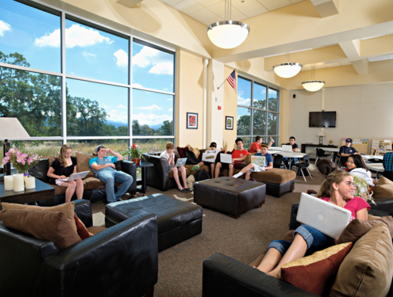
See more about the Minarets Media Lounge in From Stacks to Macs and Inspiring Learning Spaces.
Related Posts
- Student Voice - The theory, evidence, and practice of student voice, an essential component of personalizing learning because it ensures that students exercise their agency.
- How to Hire Teachers with a Next Gen Mindset – A new NGLC brief shares the hiring strategy used by Da Vinci Schools & Generation Schools Network, including ways they involve students. Access interview schedules, sample exercises, and interview questions/prompts.
- Design Thinking Infiltrates K-12 Education – Michael Niehoff writes in another post about schools at the forefront of adopting design thinking in their curriculum and school culture.



